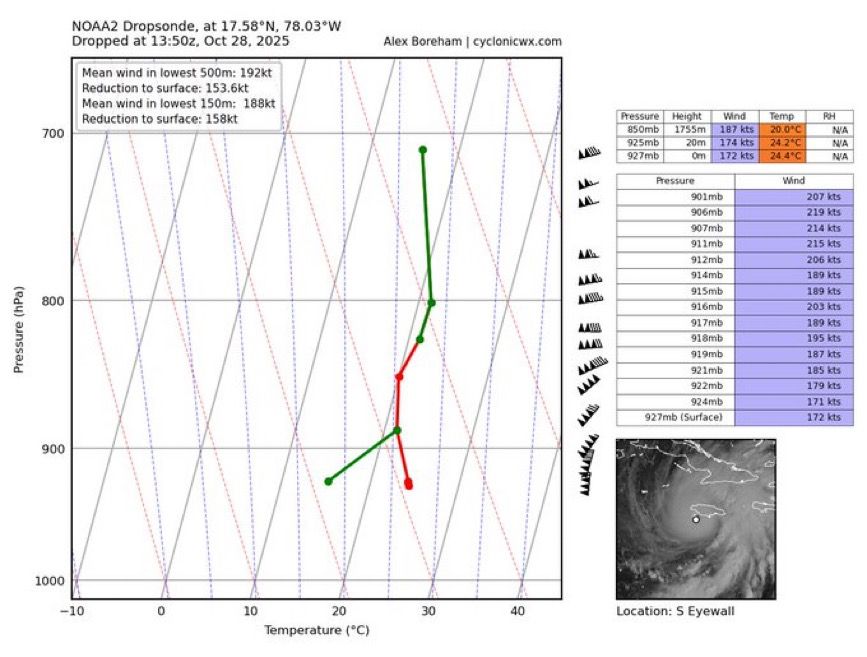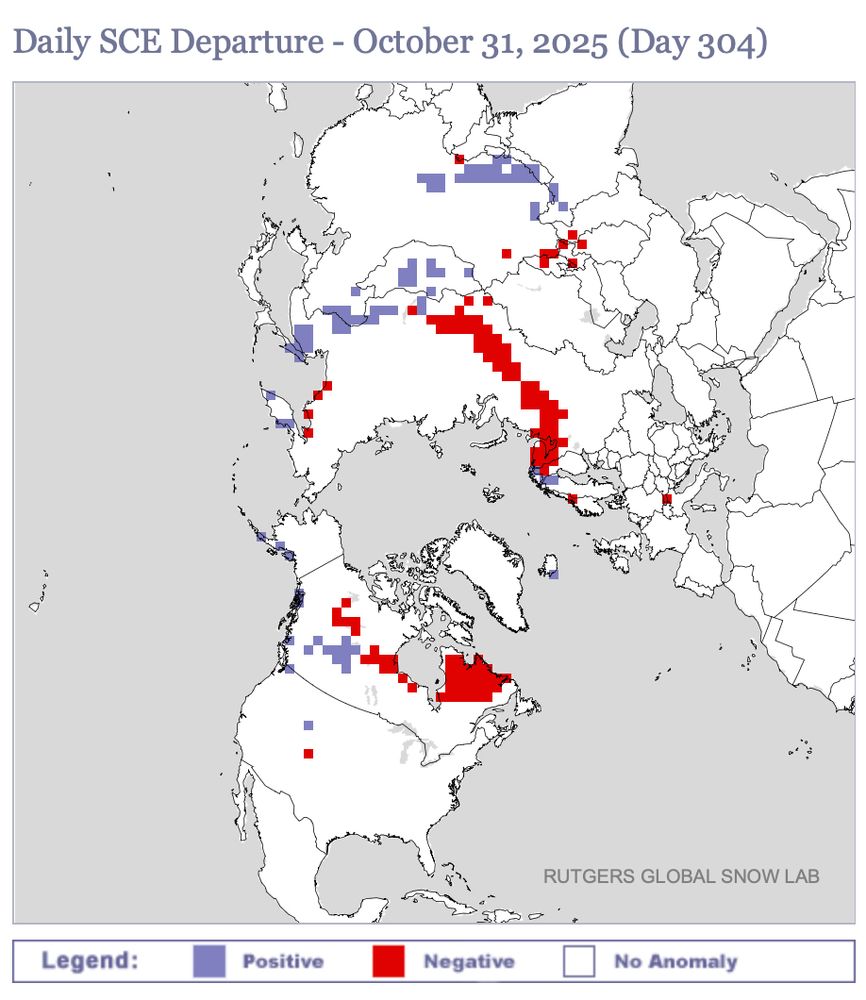
Both of these lead to the development of this pattern, which often becomes more strong/persistent late winter as it interacts w/ the stratospheric polar vortex via wave reflection.
Here's what this -EPO/+TNH or "ABNA" pattern looks like in winter (annotated over their fig 1)
01.11.2025 02:49 — 👍 9 🔁 1 💬 0 📌 0

Extending the analysis back to 1900 in 20CR (& using the Bronnimann et al (2007) QBO reconstruction) reveals a similar pattern for IPWP strength during eQBO/-ENSO winters:
01.11.2025 02:07 — 👍 2 🔁 0 💬 0 📌 0
Imho this SST trend is a "fast" ocean dynamical thermostat response to the increasingly warmer climate
The atmosphere's hydrostatic adjustment to vertical advection of water from depth that warms less quickly in the Eq Pacific is reinforced by Bjerknes feedback, making the trend look "La Nina-like"
31.10.2025 22:31 — 👍 4 🔁 0 💬 0 📌 0


This is what the 500mb difference looks like for these east QBO/cool ENSO winters based on IPWP warm pool strength (left)
This is almost exactly what the long-term 500mb trend looks like (right), which isn't surprising given that IPWP is warming at a faster rate than the adjacent tropical oceans
31.10.2025 22:23 — 👍 9 🔁 0 💬 3 📌 0


Much like last year, the very warm Tropical Indo-Pacific Warm Pool (IPWP) is going to play a major role in this coming winter.
Compare the current global mean SSTa (left) to the Oct-Nov Warm Pool SST [20S-20N, 90-150E] difference for east QBO/cool ENSO winters only (right)
31.10.2025 22:20 — 👍 20 🔁 0 💬 1 📌 0
Multi-panel view of the last few days of Hurricane Melissa:
↖️ GOES-19 infrared brightness temp
↗️ GOES-19 visible satellite
↙️ Hurricane hunter planes & flight paths
↘️ Recon-derived flight level wind swath
⬇️ Estimated minimum pressure from recon dropsondes
29.10.2025 22:14 — 👍 177 🔁 74 💬 3 📌 3
Dry air intrusions are suggested to not occur in the right juxtaposition relative to a TC for that to happen in +SRH environments. I think the +SRH in Melissa's environment played at least some role in its overall lack of eyewall replacement cycles.
29.10.2025 00:12 — 👍 4 🔁 0 💬 1 📌 0
The "showerhead" effect where stratiform evaporates and/or sublimates, cooling/moistening and preconditioning the mid-levels for later CI in the upshear-right quad is part of the vehicle for this to occur...
29.10.2025 00:11 — 👍 2 🔁 0 💬 1 📌 0
This modeling study points out that negative buoyancy-driven low-level subsidence from dry air intrusions are more likely to couple with super gradient flow from the inner core and converge in the low-levels near the inner core and favor secondary eyewall formation (SEF)...
29.10.2025 00:09 — 👍 3 🔁 0 💬 1 📌 0

One characteristic of Hurricane #Melissa that'll always stick w/ me is its lack of "classic" eyewall replacement cycles.
I honestly can't help but think the environmental +SRH was a factor for that, as this modeling study from earlier this yr showed:
journals.ametsoc.org/view/journal...
29.10.2025 00:02 — 👍 50 🔁 8 💬 3 📌 1
Yep that’s what it looks like 😢
28.10.2025 15:05 — 👍 4 🔁 0 💬 1 📌 0

Wow. This is easily the most ridiculous dropsonde I’ve ever seen.
188 knot mean winds in the low-levels with gusts over 250 mph
Absolutely scary and historic hurricane headed into SW Jamaica this morning
28.10.2025 14:21 — 👍 86 🔁 38 💬 5 📌 8

Let's play a game of find where local sunset occurred over Hurricane #Melissa
28.10.2025 00:04 — 👍 10 🔁 0 💬 0 📌 0
Extreme supergradient flow coupled w/ a deeper inflow layer greatly changes the distribution of winds in the low-levels of a very intense hurricane like #Melissa where you get a strong/shallow low-level jet that more easily mixes to the sfc
We can’t treat all TCs the same in this regard
27.10.2025 16:33 — 👍 10 🔁 0 💬 0 📌 1
After the conclusion of this hurricane season, we need to have a real, serious discussion about the utility and validity of sticking with standard reduction techniques for estimating sustained surface winds from flight level in really intense hurricanes.
27.10.2025 16:25 — 👍 16 🔁 0 💬 1 📌 1


This latest dropsonde in Hurricane Melissa is mind boggling.
185 knot mean winds in the lowest 150m!!!
This reduces to about 155 knots at the surface, a good bit higher than the current NHC estimate of 145 kt and actually very much in line with satellite consensus (SATCON)
27.10.2025 16:19 — 👍 29 🔁 8 💬 0 📌 1
Yep.
Even standard reduction techniques on these sonde profiles or even from flight level winds are probably not as reliable with high-end hurricanes like this due to more efficient BL mixing & a stronger LLJ.
27.10.2025 14:17 — 👍 1 🔁 0 💬 0 📌 0
Alex reduces these winds to the surface and accounts for these sort of things. Dropsondes are extremely unlikely to sample the strongest volume of wind in a hurricane, and studies like the one linked here have shown that this leads to an underestimate of the winds by at least 10%, if not more.
27.10.2025 14:00 — 👍 1 🔁 0 💬 1 📌 0


Even with all of the structural, intensity, and SST/OHC changes underneath Hurricane #Melissa the last few days, the diurnal cycle still remains undefeated and inevitable
27.10.2025 13:57 — 👍 21 🔁 4 💬 1 📌 1
The crazy thing is, even a dropsonde that hits the “perfect” spot in a hurricane is likely to underestimate the winds by at least 10% due to sampling biases
journals.ametsoc.org/view/journal...
27.10.2025 13:41 — 👍 13 🔁 0 💬 2 📌 0

Holy mackerel, what a dropsonde….
This explicitly supports Melissa being a 145-150 knot hurricane 😳
27.10.2025 13:09 — 👍 45 🔁 9 💬 1 📌 2
Melissa strengthened into a cat 5 hurricane overnight, w/ winds of ~160 mph & central pressure of 913mb.
Even more strengthening is likely later today, which may put this storm in pretty rarified air historically for Atlantic hurricanes.
Awful situation unfolding for much of Jamaica
27.10.2025 12:56 — 👍 33 🔁 9 💬 1 📌 2

This is probably the most tone deaf take I've seen from a professional on wxtwitter and social media more broadly speaking during a natural disaster. Not a good look.
27.10.2025 07:06 — 👍 12 🔁 1 💬 5 📌 0

Man tropical weenies are getting trolled hard tonight
27.10.2025 05:19 — 👍 6 🔁 0 💬 0 📌 0
It is worth mentioning too that Dvorak and other satellite based intensity estimates have been consistently running hot with Melissa/overestimating its intensity
I suspect that’s because of the high tropopause heights we tend to see in the Caribbean in Oct, which ultimately favor colder cloud tops.
27.10.2025 03:56 — 👍 8 🔁 0 💬 0 📌 0
Diurnal maximum coupled with exceptional upper-level divergence (to compensate for subsidence warming), & high background tropopause heights, typical of the low-latitude tropical Atlantic in October, means you have a CDO that is *very* efficient at cooling/radiating longwave IR out into space
27.10.2025 03:49 — 👍 4 🔁 1 💬 1 📌 0
Atmospheric Scientist in Monterey, CA
Hurricanes and Arctic Cyclones
🏳️🌈
Hurricane Specialist and Storm Surge Expert at Miami's WPLG-TV Local 10 News. Posts my own.
http://linktr.ee/michaelrlowry
Meteorologist for WLUK-TV in Green Bay, WI. Born and raised on the Jersey shore. Penn State grad, Mets/Jets/Knicks sufferer, husband, human dad, cat dad.
(he/him) Agroclimatologist studying climate and food. Assistant research professor working at the University of Maryland. All opinions expressed are my own and not those of my employer
Climate scientist, Senior Editor at Nature Communications, Lover of clouds, books, art, diversity. Opinions are mine.
Currently Meteorologist at NWS Binghamton, former observer at Mt Washington, graduate from University of North Dakota.
Climate specialist with ACCAP/IARC at UAF, highlighting Alaska and Arctic climate, environment & Indigenous cultures. Opinions are my own.
Alaska and Arctic Climate Newsletter: https://alaskaclimate.substack.com/
Senior Climate+Weather Director @ CNN
Meteorologist | Mississippi State '22 | WxComm | BoyMom | Lover of condensation ☁️, convection 🌩, coffee ☕️, and cats 🐈
I sometimes write about weather here: https://meteorologicalmeg.substack.com/
Jaded, early fifties gen-x ex x-er. Background in risk, natural hazards and disaster modelling within the insurance industry. Climate change is unfortunately real -past time to take it seriously. Also: Cycling, Aberdeen FC, The Scottish Highlands.
PhD student @BSC | Climate and stats
llplm.github.io
Climate scientist & Assistant Prof @UDelaware Dept Geog & Spatial Sciences 🌍⛈️ | Ph.D. UMiami Rosenstiel 🌀| B.S. UMD 🐢 | often post about weather & climate | she/her
Assistant Vice President @GallagherRe | Adjunct Associate Research Scientist @LamontEarth @ColumbiaClimate | Studying climate with a focus on #ExtremeEvents | Views are my own.
Storm chaser. Husband. Lover of nature.
I run storm chase tours. Join us!
https://darksky-adventures.com/
Weather and Climate for NBCUniversal Local, Meteorologist for the Wolfpack, GirlDad x 4, Husband, Frequent flier, Occasional pilot. Will work for barbecue. @nsj on Twitter, @wx4nsj on Instagram/Threads, nsj.919 on Signal.
Weather and nature nerd, occasional photographer. BS in Geology, MS in Environmental Geoscience. Florida transplant living her dream in Washington state!
Meteorologist & Operations Manager for OpenSnow. B.S. in Meteorology from Metro State University of Denver. Native of Greenville, SC. Main focuses on powder forecasting, mountain weather forecasting, and severe weather forecasting.
Meteorologist🌦️ | VT Alumni ‘20 🦃
Meteorologist & car safety systems. husband, father, Chattahooligan. He/him
Retweets are only endorsements if weather. You can like bad weather posts, it doesn't make you a bad person





























